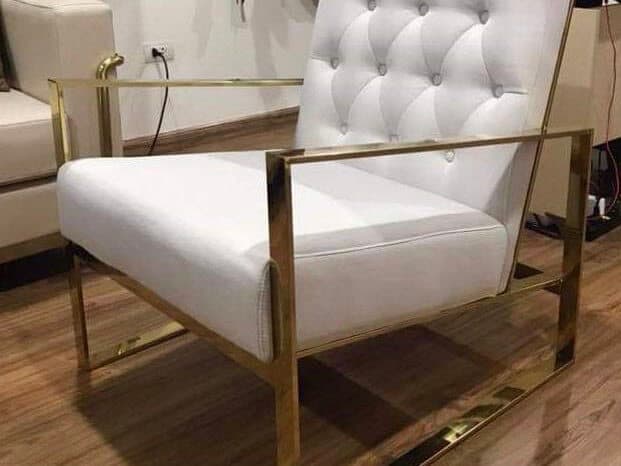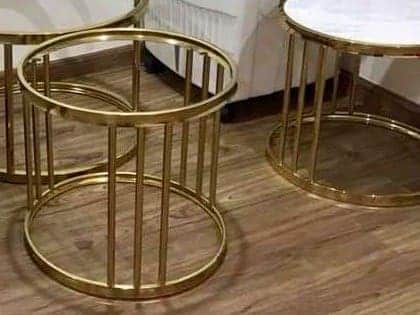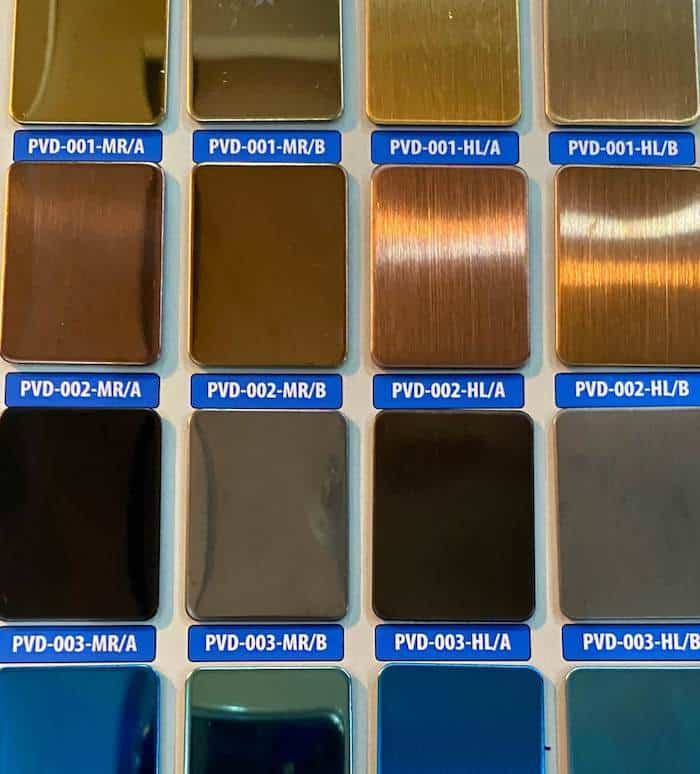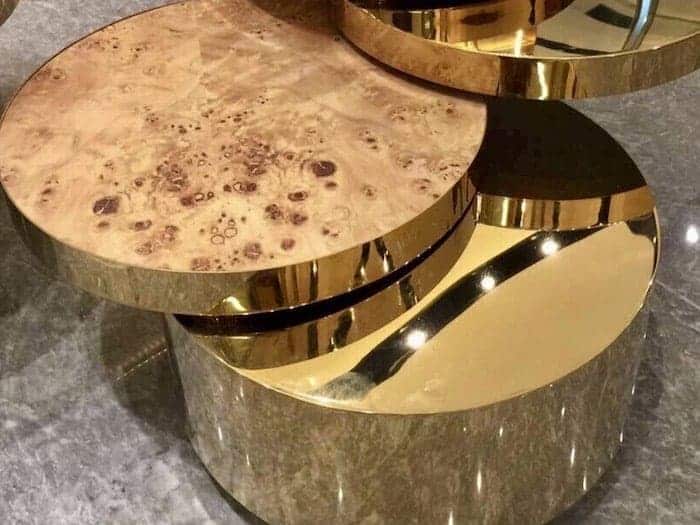A popular coating on stainless steel called PVD is used to manufacture many furniture and other home decor items. This finish is not only beautiful but also enduring.
PVD coatings are thin yet highly durable on many different substrates, including stainless steel. A vacuum chamber with very high temperatures is used to apply the PVD coating. Though this finish is used in the tech, medical, and aerospace industries, it is also used for home decor and furniture products.
Table of Contents
- What is the PVD Stainless Steel Coating?
- What Are PVD Applications or Uses?
- What are the uses of PVD Finishes in the Home Decor and Home Furnishing Industry?
- Other Information On PVD Finishes
- Related Content

What is the PVD Stainless Steel Coating?
PVD coatings are thin-film coatings where a solid material is placed on another material to produce a lasting coat. In our case, we place the PVD coating on stainless steel. The thin coatings are between 0.5 and 5 microns, depending on the color and required process.
PVD stands for Physical Vapor Deposition. Basically, what this means in layman’s terms is that a skinny coat of a metal vapor is placed on the surface of an object through a vacuum chamber and very high temperatures.
The basic process of producing a PVD stainless steel finish:
- Vacuum Chamber – The solid material is vaporized in a vacuum chamber.
- High Temperature – In the vacuum chamber, the temperature is between 122 to 1,112-degree Fahrenheit (50 to 600 degrees Celsius). So it is fired at extremely high temperatures.
- Deposit on Material – The PVD gets deposited or placed on the material in the vacuum chamber.
- Needs to Rotate – Usually, while applying a PVD coating, the object needs to be rotated to ensure the heat and the application are even. The chamber position and rotation is an essential part of the PVD coating.
- Coating Properties- When the PVD coating is placed on the metal’s surface, it then changes the properties of the metal itself.
- Very Thin Coatings – The PVD is a very thin coating, usually between 0.5 and 5 microns depending on the color and the required process.
Some people may think this is the same thing as powder coating or painting the metal, but in reality, it is very different to manufacture a PVD coating; you must have the right equipment and a large enough vacuum chamber even to do this of coating. You cannot get the same properties, look or finish with any other process.
What Are PVD Applications or Uses?
PVD has a wide range of uses, and the coating can be placed on various materials and substrates. In the home decor and home furnishing industry, the PVD finish is placed mainly on stainless steel, but it is interesting to know the other ways it can and is being used.
- PVD Coating Metals – The PVD coating uses titanium, zirconium, aluminum, stainless steel, copper, and gold. The gold coating is usually for the aerospace industry.
- Substrates with PVD coating – The substrates for the PVD application can be applied to ceramics, nylon, plastics, glass, and metals like stainless steel and aluminum.
- Industries that use PVD – Besides the furniture and home decor industry, PVD is used in many other industries. PVD coatings are commonly found in the high-tech industry. They are also used for aerospace, and titanium medical implants, and surgical tools. The PVD gold film is used a lot in the electronics industry. PVD coating is also used in the semiconductor parts and industrial tools industry. It is also used on items like golf clubs or watch hardware. Your Apple Space Grey Watch and many Apple Phones have PVD coatings.
As you can see many other industries use PVD coatings much more than the home decor or home furniture industry. There are several reasons for this:
- PVD properties – The PVD finish is tough, giving a hard surface. Also, it has a low coefficient of friction, anti-corrosion, and wear resistance. These are all essential qualities, especially for the high-tech or medical industry. Those are all qualities you want to have if, for example, you have a plate put in your ankle, as I had from a motorbike accident.
- Thin Coatings – As the PVD coatings are extremely thin, i.e., 0.5 microns to 5 microns, when they are coating precision tools, it will not throw the specification off for the precision tool or part.
- Extremely Durable – Even though the PVD coat is extremely thin, being only a .5 or a few microns, it is nearly impossible to remove and wear off once the coating is applied. This is why the PVD coating is so popular and has many applications and uses.

What are the uses of PVD Finishes in the Home Decor and Home Furnishing Industry?
In the home decor and home furnishing industry, PVD is usually placed on stainless steel. Placing PVD on stainless steel gives a variety of interesting colors, looks, and finishes.
The PVD finish is quite technical and complicated to produce and requires excellent equipment and skills from the factory making the PVD coating. So the PVD finish is usually more costly than using a finish like a gold leaf finish on metal or a basic powder coat. But we have found it is usually cheaper than solid brass. But the actual cost would need to be confirmed for each product and each use as there are a lot of variables as to the pricing on the PVD finish and other types of metal.
One of the great things about the PVD finish is that this is one of the toughest and most durable finishes out in the market today. This makes it a critical finish for the home decor and furniture businesses.
Exploring the Basics: PVD Finishes in the Home Decor and Furniture Industry
In the home decor and furniture industry, the quest for durable, aesthetically pleasing finishes has led to the adoption of Physical Vapor Deposition (PVD) techniques. This section delves into the fundamental uses of PVD finishes, highlighting how this advanced technology is revolutionizing the appearance and longevity of home furnishings and decor.
PVD finishes not only offer an impressive range of colors and textures but also provide enhanced durability and resistance to wear, making them an increasingly popular choice among designers and manufacturers.
Whether you’re a professional in the industry or a homeowner looking to understand the latest furniture finishing, this overview will shed light on the essential aspects of PVD finishes and their growing significance in home interiors.
Here are some of the basic uses for a PVD finish in the home decor and home furniture industry:
- Table Bases – One of the most common ways PVD is used is for table bases. This is because the base is vital, so even heavy materials as a large marble piece, can be placed on top of the PVD base. The durability of the PVD finish is also one reason that the PVD finish is also used a lot in the hotel contracting Industry.
- Chair bases – A PVD metal base can be used as a chair base. Everything from smaller chairs to larger chairs or even a sofa frame. The ability to do the larger frames will, of course, depends on the size of the vacuum chamber that the supplier has, as the size of the vacuum chamber will limit the PVD supplier.
- Mirror Frames and Wall Art – The PVD finish could be made into a mirror frame or a wall art piece.
- Hardware and parts – We have used PVD finishes for hardware and parts for other items such as boxes, trays, lamps, mirrors, and wall art. Just about anything where you need or want to have a PVD part on. This is perhaps one of the best ways to use PVD finishes, in that you use the PVD finish as part of a design in home decor or home furniture items.

We love the PVD finish as it has a great look and is extremely durable. We feel like it is an amazing finish that can be used in various home decor and home furniture products.
If you are interested in developing some home decor and furniture products with PVD, please contact Anita at Mondoro by clicking here for more information.
Other Information On PVD Finishes
Is the PVD Coating Safe?
The PVD coating is safe. The food safety of the PVD coating is inert. Also, the surface is extremely tough and durable, so the PVD coating should not chip, crack, or break. This also makes the PVD coating extremely safe and tough for many uses. The fact this is used so much in the high-tech, medical, and aerospace industries also testifies how safe and durable the PVD coating is.
How Do You Clean a PVD Coating?
You need to use a soft cloth with mild soap and water to clean your PVD products. You should avoid all cleaning products designed to remove rust or tarnish, as these could damage or change the PVD coating.
Do not use any of these substances in any cleaning agents or products on a PVD coating:
- hydrochloric
- hydrofluoric
- phosphoric acid
- caustic agents
o learn more about how Mondoro can help you create, develop, and manufacture excellent home decor and furniture products – including brass items – don’t hesitate to contact me, Anita. Check out my email by clicking here or become a part of our community and join our newsletter by clicking here.
Mondoro gives out a FREE Lookbook to anyone interested. You can receive a copy of our latest Lookbook by clicking here.
Listen to our Podcast called Global Trade Gal. You can find it on all major podcast platforms. Try out listening to one of our podcasts by clicking here.
Subscribe to our Mondoro Company Limited YouTube Channel with great videos and information by clicking here.
Related Content
Which Is Better, Nickel Or Brass?
Nickel and brass are both excellent metal choices. Brass is a golden yellow color, and Nickel is silver or almost grey. Both metals can be plated onto another metal or material, and brass can also be solid brass.
You can discover more by reading Which Is Better Nickel Or Brass? by clicking here.
Are Brass And Nickel The Same?
Both Brass and Nickel are metal finishes that can be electroplated or plated. They contain copper and can be made into various unique and exciting looks and finishes. Because of their versatility, they remain popular metals and finishes for various products and uses.
You can find out more by reading our blog Are Brass And Nickel The Same? by clicking here.
Brass Plated Vs. Chrome Plated Metals Explained
Brass and chrome are plated on metal using the same electroplating method, but the look and finish are different. Brass will be warm golden, whereas Chrome will look like shiny silver metal. Both are excellent electroplated treatments and choosing one can also depend on the look you want for a specific product.
You can discover more by reading Brass Plated Vs. Chrome Plated Metals Explained by clicking here.

